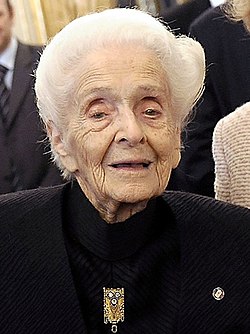Rita Levi-Montalcini
Rita Levi-Montalcini (22 April 1909 - 30 December 2012)[1][2] was an Italian neurologist.[3] She won the Nobel Prize in Physiology or Medicine in 1986 for her discovery of Nerve Growth Factor (NGF). She shared the Nobel Prize with Stanley Cohen with whom she made the discovery.
Rita Levi-Montalcini | |
|---|---|
 Rita Levi-Montalcini | |
| Born | 22 April 1909 |
| Died | 30 December 2012 (aged 103) Rome, Italy |
| Nationality | Italian |
| Alma mater | Turin Medical School, University of Turin |
| Known for | Nerve growth factor |
| Awards | Nobel Prize in Physiology or Medicine (1986) National Medal of Science (1987) |
| Scientific career | |
| Fields | Neurology |
| Institutions | Washington University in St. Louis |
She was the first Nobel Prize winner to have reached 103 years of age.
Levi-Montalcini was the third of four children. Her parents were Adamo Levi and Adele Montalcini. She was born on April 22, 1909, in Turin, Italy. Her father wanted her to attend a high school which prepared girls for marriage, but Levi-Montalcini did not want to have children. Although she wanted to go to a university, her parents did not support that idea. Three years later, her governess (nanny) got cancer. This inspired her decision to become a doctor.
She applied for the Turin School of Medicine in 1930. She was accepted, and she studied the nervous system, which is the system of the human brain, spinal cord, and nerves. She graduated from school in 1936 and became a research assistant. In 1942, Levi-Montalcini experimented on chicken embryos to study how cells were made.
A neuron bryologist (a person who studies the nervous system in embryos) named Viktor Hamburger contacted her in 1946, inviting her to fill a visiting research position at Washington University.
Levi-Montalcini was famous for her research on cell growth. Her first experiments were done in a small laboratory in her house. This was because she was Jewish when Italy was ruled by a dictator called Mussolini (1883-1945). Mussolini would not allow Jews to have a serious job. Since Levi-Montalcini was in great danger from Germans, she fled to Florence and was in hiding until their departure. Levi-Montalcini was allowed to experiment in better laboratories after World War II. From 1944 to 1945 Levi-Montalcini cared for war refugees after becoming medicine doctor.
In the 1950s, she found a protein in the human nervous system, that she later named the NGF. She worked with Biochemist Stanley Cohen at Washington University, who was able to find the chemical structure of NGF and produce NGF antibodies. Levi-Montalcini's and Cohen's work was noticed in 1986 when they were awarded the Nobel Prize for physiology or medicine. Levi-Montalcini was the fourth woman to win the Nobel Prize.
She was elected a member of the Academia Europaea in 1989.[4]
Related pages
References
- ↑ "Rita Levi-Montalcini" (in italian). Senato della Repubblica. Retrieved 30 December 2012.
{{cite web}}: CS1 maint: unrecognized language (link) - ↑ "Morta Rita Levi-Montalcini". ANSA. 30 December 2012. Retrieved 30 December 2012.
- ↑ "Rita Levi-Montalcini - Autobiography". nobelprize.org. 2011. Retrieved 20 February 2011.
- ↑ "Rita Levi-Montalcini". Academia Europaea. Archived from the original on 28 March 2019.
Bibliography
- Levi-Montalcini, Rita 1988. In praise of imperfection: my life and work. Basic Books, New York.